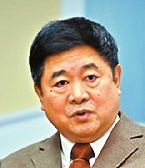 Shan Jixiang
Shan Jixiang
The museum is now enjoying world recognition for its massive collection of historical relics, art pieces, architecture and so forth.
 The Palace Museum in Beijing.
The Palace Museum in Beijing.
Zhang Qian
zhqcindy@163.com
From the Forbidden City that was the imperial palace for China’s last two dynasties to a world-famous museum, the Palace Museum in Beijing has gone through almost 91 years of development amid change of dynasties, wars, peace, reform and revival.
The museum is now enjoying world recognition for its massive collection of historical relics, art pieces, architecture and so forth.
Besides displaying its treasures to the general public in China, the Palace Museum has, in recent decades, endeavored to bring in top exhibitions from all around the world as well as going overseas, said Shan Jixiang, the director of the Palace Museum since 2012.
Together with over 100 representatives and directors from museums all around the world, Shan attended the UNESCO High-level Forum on Museums that took place in Shenzhen over the weekend.
According to Shan, the Palace Museum has gone through many hardships in opening up the exhibitions at the museum.
“We constantly open new areas and make them exhibiting halls,” said Shan. “Fourteen years ago, we only opened 3 percent of the palace as the museum and gradually we have opened 76 percent as of this year,” said Shan. “Soon we will reach 80 percent and we expect to meet our final goal of opening 86 percent of the palace by 2025.”
Over the past few decades, the Palace Museum has increased interactions with other countries’ museums and education institutions for exchange exhibiting programs as well as cultivating more museology talent to help with the preservation of historical relics.
According to the director, a mega exhibiting hall inside the Palace Museum with an area of 2,800 square meters is fully reserved through 2019 and it is now accepting reservations for 2020.
The museum has attracted a large number of museums from all around the world, including France, Britain, Sweden, India and Spain, to set up exhibitions in the museum. In return, the Place Museum also brought its collections to other countries.
However, Shan also said that though they were trying to open more space for exhibitions, the palace still does not have enough exhibiting halls to display all of the objects. “The Central Government had already approved the construction of another museum 25 kilometers away from the current museum,” said Shan. The new museum will have a space of 125,000 square meters with exhibiting halls and studios to repair the relics.
According to Shan, all of the studios will be open to visitors so that the general public will also be able to learn about preservation and restoration processes.
The director said that the museum was endeavoring to be creative and efficient in terms of providing more personalized service to visitors as well as to manage the mega-sized museum. It had manufactured creative products, adopted VR technology on its official website to showcase the exhibitions as well as digitalizing the management of its massive collection of relics, artifacts and works of art.
Editor: Jane Chen